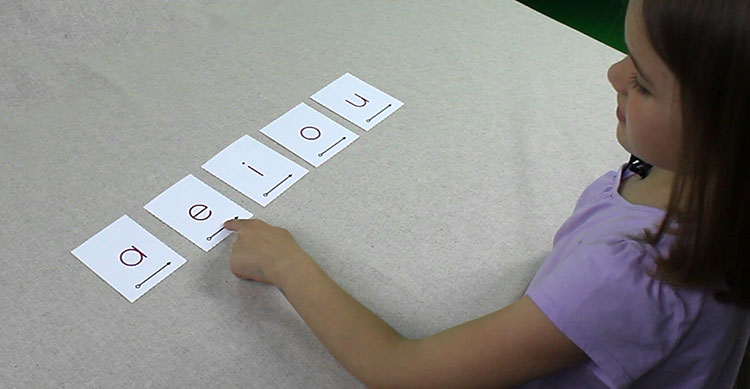J1: Vowel Names
1. Overview
Use a popular children’s song (“Bingo”) to introduce your child to the names of the vowels. You will also teach your child the terms vowel and consonant. To do the first activities in the Connecting Sounds module, children need a basic introduction to the names of the vowels, which are the same as the “long” vowel sounds. A later activity will introduce the short vowel sounds.
J1: Vowel Names
2. Materials
Print out the vowel sound cards, preferably on sturdy card-stock paper, and cut them apart. Print out the song lyrics, but these are for the adult’s reference only. The song is sung to the tune of the children’s song “Bingo.” ↑ Top3. Activity
Video: How to play Vowel Names
Start by explaining to your child that the letter sounds she has learned so far are called consonants, and she is about to learn some new letters that are called vowels.
Adult: You have learned to recognize a lot of letter sounds. The letter sounds you’ve learned and seen pictures of are called consonants. Can you say that word? Child: Consonants. Adult: Yes. Consonants are important pieces of words.Set out the five vowel sound cards, in order, in front of the child.
Adult: There are five more letters in words that I want you to know about. These letters are called vowels. Can you say vowels? Child: Vowels. Adult: Yes. Let’s go through them one at a time and learn their names.Point to the first sound card, say “A,” and have the child repeat the letter name and point to the card. Do this for each of the vowels. Repeat a few times until she gets familiar with the vowel names.
Adult: Good. Vowels are very smart and very popular. They are popular because every single word we say has at least one vowel in it that we can hear. Vowels are very smart letters because they can say two things: they can say their name, and they can say another sound. Now I’m going to teach you a song that will help you remember the names of all the vowels. Here it is. Listen:
Vowel Names Song:
Now teach the song to your child. Whenever you sing the name of a vowel, point to the appropriate sound card. As the child gets familiar with the song, have her sing with you and point to the sound cards.Adult: A – E – I – O – U, A – E – I – O – U, A – E – I – O – U, Are the NAMES of five smart letters! A – E – I – O – U, A – E – I – O – U, A – E – I – O – U. Why are vowels smart letters? ‘Cause vowels can say their NAME and a sound. ‘Cause vowels can say their name AND a sound. ‘Cause vowels can say their name and a SOUND. That’s why they’re smart letters! A – E – I – O – U, A – E – I – O – U, A – E – I – O – U. Are the NAMES of five smart letters!Continue practicing the song until the child can sing the first verse on her own and can answer the question, “Why are vowels smart letters?” Be sure to emphasize that these are the names of the letters. (She will learn the vowel sounds — a.k.a. the short vowel sounds — in a later activity.) Review this song until the child can match the vowel names to their correct pictures confidently and quickly. ↑ Top
4. Extension
Sing the song, but omit one of the vowel letters. For example, “A – E – – O – U.” The child then has to name the missing vowel and point to it. For a greater challenge, omit two of the vowel names. ↑ Top5. Variation
This is a great activity to do outside the home or classroom, such as running errands or walking to recess. ↑ Top6. Small Groups (2-5 children)
Lesson Objective: Children will state the names of the five common vowels and match the written lower-case vowels with their spoken names. GELDS (Georgia Early Learning & Development Standards): CLL7.4a Georgia Standards of Excellence: ELAGSEKRF3.b Common Core State Standards: CCSS.ELA-LITERACY.RF.K.3.B Additional Materials:- optional: pocket chart
Leave a Reply

